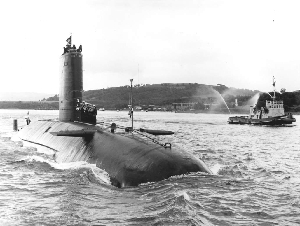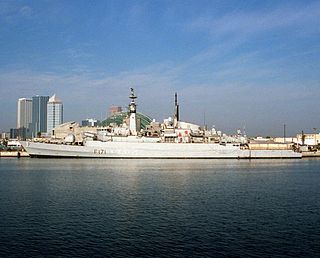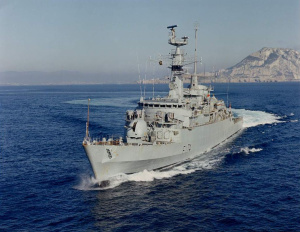
An anti-ship missile (AShM) is a guided missile that is designed for use against ships and large boats. Most anti-ship missiles are of the sea skimming variety, and many use a combination of inertial guidance and active radar homing. A large number of other anti-ship missiles use infrared homing to follow the heat that is emitted by a ship; it is also possible for anti-ship missiles to be guided by radio command all the way.

HMS Conqueror was a British Churchill-class nuclear-powered fleet submarine which served in the Royal Navy from 1971 to 1990. She was the third submarine of her class, following the earlier Churchill and Courageous, that were all designed to face the Soviet threat at sea. She was built by Cammell Laird at Birkenhead.
This is a list of the naval forces from the United Kingdom that took part in the Falklands War, often referred to as "the Task Force" in the context of the war. For a list of naval forces from Argentina, see Argentine naval forces in the Falklands War.

The Exocet is a French-built anti-ship missile whose various versions can be launched from surface vessels, submarines, helicopters and fixed-wing aircraft.

HMS Brilliant was a Type 22 frigate of the Royal Navy.

The Type 21 frigate, or Amazon-class frigate, was a British Royal Navy general-purpose escort that was designed in the late 1960s, built in the 1970s and served throughout the 1980s into the 1990s.

HMS Active was a Type 21-class frigate of the Royal Navy. Built by Vosper Thornycroft, Southampton, England, she was completed with Exocet launchers in 'B' position, the first of the class to be so fitted.

HMS Ambuscade was a Type 21 frigate of the Royal Navy. She was built by Yarrow Shipbuilders Ltd, Glasgow, Scotland. She entered service in 1975. Ambuscade took part in the Falklands War of 1982.

HMS Arrow was a Type 21 frigate of the Royal Navy.

HMS Glamorgan was a County-class destroyer of the Royal Navy with a displacement of 5,440 tonnes. The ship was built by Vickers-Armstrongs in Newcastle Upon Tyne and named after the Welsh county of Glamorgan.

Atlantic Conveyor was a British merchant navy ship, registered in Liverpool, that was requisitioned during the Falklands War.
This article describes the composition and actions of the Argentine naval forces in the Falklands War. For a list of naval forces from the United Kingdom, see British naval forces in the Falklands War.

ARA San Luis (S-32) was a Type 209 diesel-powered submarine of the Argentine Navy. Built in Germany, San Luis has a displacement of 1,285 tonnes and was commissioned in 1974. The submarine operated against the Royal Navy during the Falklands War without any noticeable success, but survived a number of anti-submarine sweeps carried out by British frigates. San Luis was struck in 1997 after an incomplete overhaul.
ARA Isla de los Estados was an Argentine Navy supply ship sunk during the Falklands War.

HMS Diomede (F16) was a Leander-class frigate of the Royal Navy. She was built by Yarrow Shipbuilders in Glasgow. Diomede was launched on 15 April 1969 and commissioned on 2 April 1971. In 1998, the vessel was taken out of service and sold to Pakistan. Renamed PNS Shamsheer, the vessel served with the Pakistan Navy until being scrapped.
HMS Phoebe (F42) was a Leander-class frigate of the Royal Navy (RN). She was, like the rest of her class, named after a figure of mythology. Built by Alexander Stephen and Sons on the River Clyde, she was launched on 19 December 1964 and commissioned on 15 May 1966.

HMS Yarmouth was the first modified Type 12 frigate of the Rothesay class to enter service with the Royal Navy.

HMS Tiger Bay was a Z-28-class patrol boat operated by the British Royal Navy, previously the Argentine Coast Guard vessel PNA Islas Malvinas (GC-82), which was seized at Port Stanley by the crew of HMS Cardiff on 14 June 1982 following the Argentine surrender during the Falklands War.

PNS Badr (D-184) was the Tariq-class destroyer that served in the Surface Command of the Pakistan Navy from 1994 until being decommissioned from the service in 2014.

The Falklands Naval Station was the main base of the naval component of Argentina in the Falklands Islands, during the South Atlantic conflict of 1982.















